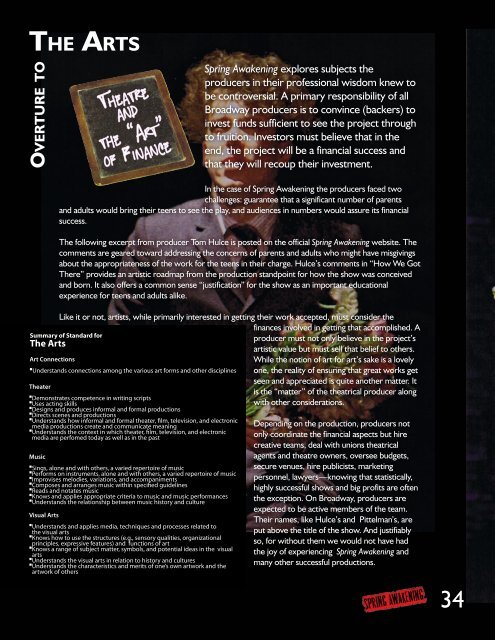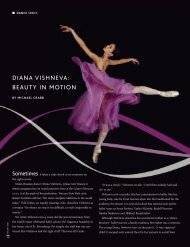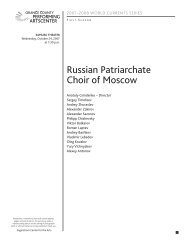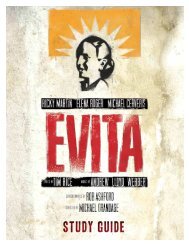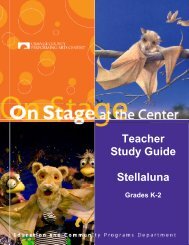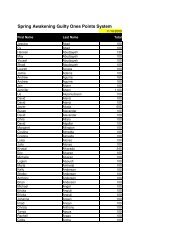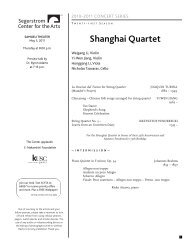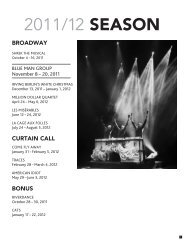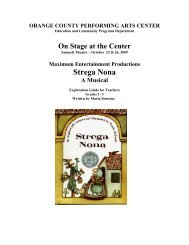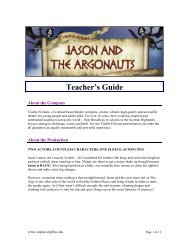SPRING AWAKENING - Segerstrom Center for the Arts
SPRING AWAKENING - Segerstrom Center for the Arts
SPRING AWAKENING - Segerstrom Center for the Arts
You also want an ePaper? Increase the reach of your titles
YUMPU automatically turns print PDFs into web optimized ePapers that Google loves.
The <strong>Arts</strong><br />
Overture to<br />
Theatre<br />
and<br />
<strong>the</strong> “Art”<br />
of Finance<br />
Spring Awakening explores subjects <strong>the</strong><br />
producers in <strong>the</strong>ir professional wisdom knew to<br />
be controversial. A primary responsibility of all<br />
Broadway producers is to convince (backers) to<br />
invest funds sufficient to see <strong>the</strong> project through<br />
to fruition. Investors must believe that in <strong>the</strong><br />
end, <strong>the</strong> project will be a financial success and<br />
that <strong>the</strong>y will recoup <strong>the</strong>ir investment.<br />
In <strong>the</strong> case of Spring Awakening <strong>the</strong> producers faced two<br />
challenges: guarantee that a significant number of parents<br />
and adults would bring <strong>the</strong>ir teens to see <strong>the</strong> play, and audiences in numbers would assure its financial<br />
success.<br />
The following excerpt from producer Tom Hulce is posted on <strong>the</strong> official Spring Awakening website. The<br />
comments are geared toward addressing <strong>the</strong> concerns of parents and adults who might have misgivings<br />
about <strong>the</strong> appropriateness of <strong>the</strong> work <strong>for</strong> <strong>the</strong> teens in <strong>the</strong>ir charge. Hulce’s comments in “How We Got<br />
There” provides an artistic roadmap from <strong>the</strong> production standpoint <strong>for</strong> how <strong>the</strong> show was conceived<br />
and born. It also offers a common sense “justification” <strong>for</strong> <strong>the</strong> show as an important educational<br />
experience <strong>for</strong> teens and adults alike.<br />
Like it or not, artists, while primarily interested in getting <strong>the</strong>ir work accepted, must consider <strong>the</strong><br />
finances involved in getting that accomplished. A<br />
producer must not only believe in <strong>the</strong> project’s<br />
artistic value but must sell that belief to o<strong>the</strong>rs.<br />
While <strong>the</strong> notion of art <strong>for</strong> art’s sake is a lovely<br />
one, <strong>the</strong> reality of ensuring that great works get<br />
seen and appreciated is quite ano<strong>the</strong>r matter. It<br />
is <strong>the</strong> “matter” of <strong>the</strong> <strong>the</strong>atrical producer along<br />
with o<strong>the</strong>r considerations.<br />
Summary of Standard <strong>for</strong><br />
The <strong>Arts</strong><br />
Art Connections<br />
•<br />
Understands connections among <strong>the</strong> various art <strong>for</strong>ms and o<strong>the</strong>r disciplines<br />
Theater<br />
•<br />
Demonstrates competence in writing scripts<br />
•<br />
Uses acting skills<br />
•<br />
Designs and produces in<strong>for</strong>mal and <strong>for</strong>mal productions<br />
•<br />
Directs scenes and productions<br />
•<br />
Understands how in<strong>for</strong>mal and <strong>for</strong>mal <strong>the</strong>ater, film, television, and electronic<br />
media productions create and communicate meaning<br />
•<br />
Understands <strong>the</strong> context in which <strong>the</strong>ater, film, television, and electronic<br />
media are perfomed today as well as in <strong>the</strong> past<br />
Music<br />
•<br />
Sings, alone and with o<strong>the</strong>rs, a varied repertoire of music<br />
•<br />
Per<strong>for</strong>ms on instruments, alone and with o<strong>the</strong>rs, a varied repertoire of music<br />
•<br />
Improvises melodies, variations, and accompaniments<br />
•<br />
Composes and arranges music within specified guidelines<br />
•<br />
Reads and notates music<br />
•<br />
Knows and applies appropriate criteria to music and music per<strong>for</strong>mances<br />
•<br />
Understands <strong>the</strong> relationship between music history and culture<br />
Visual <strong>Arts</strong><br />
•<br />
Understands and applies media, techniques and processes related to<br />
<strong>the</strong> visual arts<br />
•<br />
Knows how to use <strong>the</strong> structures (e.g., sensory qualities, organizational<br />
principles, expressive features) and functions of art<br />
•<br />
Knows a range of subject matter, symbols, and potential ideas in <strong>the</strong> visual<br />
arts<br />
•<br />
Understands <strong>the</strong> visual arts in relation to history and cultures<br />
•<br />
Understands <strong>the</strong> characteristics and merits of one’s own artwork and <strong>the</strong><br />
artwork of o<strong>the</strong>rs<br />
Depending on <strong>the</strong> production, producers not<br />
only coordinate <strong>the</strong> financial aspects but hire<br />
creative teams, deal with unions <strong>the</strong>atrical<br />
agents and <strong>the</strong>atre owners, oversee budgets,<br />
secure venues, hire publicists, marketing<br />
personnel, lawyers—knowing that statistically,<br />
highly successful shows and big profits are often<br />
<strong>the</strong> exception. On Broadway, producers are<br />
expected to be active members of <strong>the</strong> team.<br />
Their names, like Hulce’s and Pittelman’s, are<br />
put above <strong>the</strong> title of <strong>the</strong> show. And justifiably<br />
so, <strong>for</strong> without <strong>the</strong>m we would not have had<br />
<strong>the</strong> joy of experiencing Spring Awakening and<br />
many o<strong>the</strong>r successful productions.<br />
34


